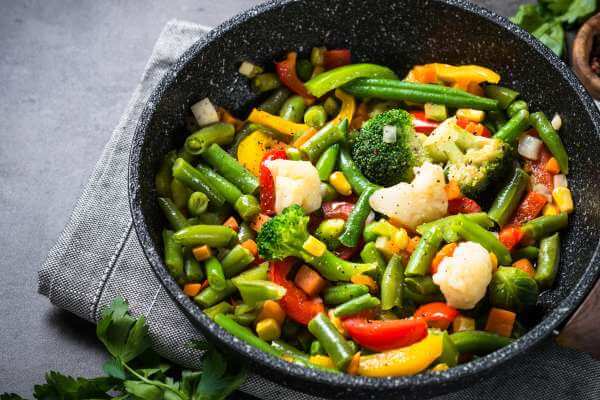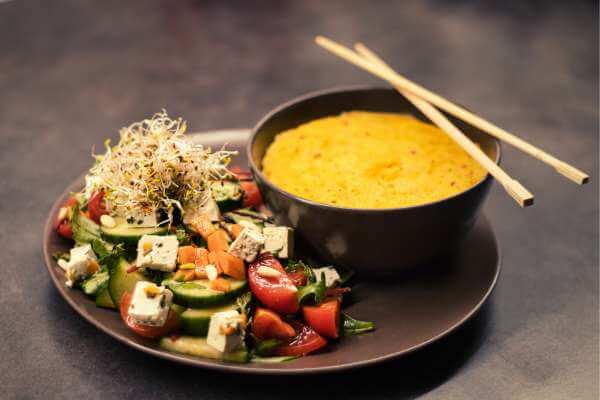The rise of plant-based diets has sparked a culinary revolution, inspiring chefs and home cooks alike to explore innovative and delicious vegan cooking techniques. In this article, we’ll delve into the world of modern kitchen vegan cooking techniques that not only cater to plant-based preferences but also elevate the dining experience.
Modern Vegan Cooking Techniques
1. Plant-Based Protein Innovation:
Cooks are replacing traditional protein sources like meat and dairy with innovative plant-based alternatives. They manipulate and transform tofu, tempeh, seitan, and legumes using various cooking techniques to mimic the textures and flavors of animal-based proteins.
2. Vegetable Butchery:
Vegetable butchery involves treating vegetables with the same precision and attention as animal meats. This technique includes cutting, marinating, and cooking vegetables to replicate the textures and flavors typically associated with meat dishes.
3. Fermentation:
Fermentation is a timeless technique that has found a new spotlight in vegan cooking. Fermented foods not only enhance flavor but also contribute to gut health. Techniques like fermenting cashews for creamy cheese alternatives or creating tangy kimchi showcase the versatility of this method.
4. Sous Vide for Vegetables:
Sous vide, a cooking method where food is vacuum-sealed and slow-cooked in a water bath, is no longer reserved for meat. Vegetables can be sous vide to perfection, preserving their natural flavors and nutrients while achieving the desired level of tenderness.
5. Dehydrating for Texture:
Dehydrating is employed to intensify flavors and create unique textures in vegan cooking. From creating crispy kale chips to crafting chewy dried fruits, dehydrating adds complexity and depth to plant-based dishes.
6. Modern Plating Techniques:
Presentation plays a significant role in modern vegan cuisine. Chefs are using avant-garde plating techniques to elevate the visual appeal of plant-based dishes, making them as aesthetically pleasing as they are delicious.
7. Aquafaba Magic:
Aquafaba, the liquid from canned chickpeas, has become a staple in vegan cooking. It can be whipped into meringues, used as an egg substitute in baking, or transformed into creamy mayo. The versatility of aquafaba showcases the endless possibilities of plant-based ingredients.
8. Molecular Gastronomy for Vegan Dishes:
Molecular gastronomy techniques, such as spherification and foaming, are not limited to animal-based ingredients. Chefs are experimenting with these methods to create avant-garde vegan dishes that surprise and delight the palate.
9. Culinary Smoking and Infusing:
Infusing plant-based dishes with smoky flavors adds depth and complexity. Techniques like cold-smoking vegetables or using smoked oils contribute a rich and savory element to vegan recipes.
10. Innovative Dessert Making:
Vegan desserts have come a long way from basic fruit salads. Chefs are utilizing aquafaba, coconut cream, and plant-based alternatives to create decadent desserts, showcasing that indulgence can be cruelty-free.
FAQ
Do vegans fry their food?

As long as the frying fat doesn’t originate from animal tissue, it aligns with the fundamental tenets of a vegetarian diet. Furthermore, if the frying fat originates entirely from plants, it aligns with the principles of a vegan diet.
How to get vegan food to taste like meat?
Cooks make vegan food taste like meat by combining cooking techniques and using specific ingredients that mimic the flavors and textures of animal products. Here are some of the key strategies:
Protein Sources
Chefs often use plant-based proteins like soy (tofu, tempeh), wheat gluten (seitan), and pea protein as the base for vegan meats because they can manipulate their textures to mimic the fibrous structure of animal muscle.
Flavoring Agents
Use Ingredients like soy sauce, tamari, liquid smoke, nutritional yeast, and various spices and herbs to impart umami and meat-like flavors. Vegan recipes might use smoked paprika for a smoky flavor or add fennel seeds to simulate the taste of sausage.
Fats
Vegan use of coconut oil, vegetable shortening, and other plant-based fats can replicate the mouthfeel of animal fats.
Colorants
To visually mimic meat, natural colorants like beet extract, pomegranate powder, and caramel color are used to achieve the red or brown hues associated with different types of meat.
Binding Agents
To create a cohesive texture, binding agents such as agar-agar, tapioca starch, or xanthan gum may be used in vegan meat products.
Heme
Some companies, like those producing the Impossible Burger, use soy leghemoglobin, which contains heme, the molecule that gives blood its red color and contributes to the characteristic taste of meat.
Cooking Techniques
Grilling, smoking, and marinating all help to develop deeper flavors that are reminiscent of meat. The Maillard reaction, a chemical reaction that occurs when proteins and sugars are exposed to heat, is particularly important for creating complex flavors.
Texturizing
Mechanical processes such as extrusion can alter the texture of plant proteins, making them chewy or tender like meat.
By carefully combining these elements, food scientists and chefs can create vegan foods that satisfy the taste and texture expectations of meat-eaters, making plant-based diets more accessible and enjoyable for a broader audience.
Conclusion: The Future of Vegan Cooking Techniques

Modern vegan cooking techniques embrace creativity, sustainability, and a deep respect for plant-based ingredients. As chefs and home cooks continue to experiment and push the boundaries, the world of vegan cuisine evolves into a realm of infinite possibilities, challenging preconceived notions and proving that delicious, innovative dishes can thrive without animal products. Whether you’re a seasoned chef or a home cook eager to explore the world of vegan cooking, these techniques offer a delicious entry point into the modern era of plant-based gastronomy.
Read also: Gluten-Free Baking in Modern Kitchen


 Hi, my name is Debra Klein and I love modern kitchen designs! As a product reviewer, it’s my mission to help homeowners choose the right modern kitchen accessories for their homes. I want to give them the best solution possible so they can make the best decision for their needs. Thanks for reading!
Hi, my name is Debra Klein and I love modern kitchen designs! As a product reviewer, it’s my mission to help homeowners choose the right modern kitchen accessories for their homes. I want to give them the best solution possible so they can make the best decision for their needs. Thanks for reading!




